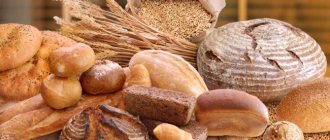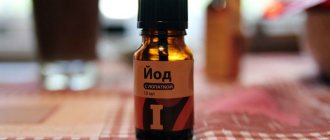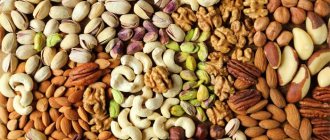Along with proteins and carbohydrates, fats are a basic micronutrient necessary for life. They serve as the main source of energy for the body.
Fat is an organic substance that is a concentrated source of calories. It enhances the taste of many foods, making them more nutritious, but unlike fiber, it does not give a feeling of fullness.
We consume fat in the form of triglycerides. A triglyceride molecule consists of three fatty acids, which in turn contain chains of carbon and hydrogen.
One way to classify fats is by the length of their carbon chains:
- Short chain fatty acids: less than 6 carbon atoms.
- Medium chain fatty acids: 6–12 carbons.
- Long chain fatty acids: 13–21 carbons.
- Very long chain fatty acids: 22 or more carbon atoms.
Most of the fats we consume are long chain fatty acids.
Edible fats can be of vegetable origin (sunflower, olive, flaxseed oil, etc.) and animal (lard, butter, fish oil, etc.), and by consistency - liquid and solid.
Types of dietary fats
Functions of fats in the body
Fats perform a number of vital functions:
- Energy.
Fat provides a huge influx of energy, which is almost impossible to achieve by consuming only proteins and carbohydrates. Each gram of fat provides 9 calories. By comparison, proteins and carbohydrates provide only 4 calories per gram of weight. Without fat reserves, our body literally begins to eat itself, breaking down tissue and muscle in search of material for energy production. - Hormones and genes.
According to the study, fats regulate the production of reproductive and steroid hormones, and also lead to changes in metabolism, cell growth and differentiation. During menopause in women, fat partially takes over the function of the ovaries and produces sex hormones. - Protection.
Organs in the human body are enveloped by a fatty membrane, which helps insulate them from injuries, concussions and other environmental influences. - Brain activity.
Adequate fat intake is important for brain health and also has a positive effect on mood and reduces irritability. - Absorption of vitamins A, D, E and
K. They dissolve thanks to fats. - Appearance.
When consuming enough fat, the skin becomes elastic and firm; if there is a lack of microelement, you may notice dryness and flaking. - Thermoregulation
. Fats protect the body from hypothermia and act as a heat insulator.
It is worth noting that there are fats that benefit the body and are necessary for the normal functioning of the body, as well as those that have a negative effect and lead to disease. But first things first.
Positive and negative properties of dietary fats
Vitamins to strengthen teeth and gums: a selection of the most popular drugs
Discussion: 10 comments
- Daniel:
03/29/2018 at 00:19In our society today there is such a problem as excessive consumption of trans fats and carbohydrates. Of course, fats are needed, but healthy ones, such as vegetable and fish ones. But you don't need a lot of fat. It is enough to eat scrambled eggs from three whole eggs in the morning and a person will receive the necessary amount of healthy fats.
- Anna:
04/04/2018 at 00:46
By their reflection in the mirror and the numbers on the scale, everyone can easily understand whether they are consuming enough fat or not, and perhaps even above the norm. I have been on a diet for some time and I can say that due to my hormonal background, I first felt the lack of fat. It is important for women to eat a balanced diet.
- Irina:
04/17/2018 at 07:20
Every body needs fats, but you must consume them in the right form. I have long given up sausages and sausages, which have nothing healthy in them. But I often started eating fish; I steam it or cook it in a slow cooker. Both tasty and healthy.
- Inga:
04/25/2018 at 04:26
Fats are necessary in the diet, but in a certain ratio with proteins and carbohydrates. If you listen to bad advice and try to eliminate lipids from your diet as much as possible, this can lead to dry skin and serious hormonal imbalances.
- E.Z. Loktionova:
04/26/2018 at 00:22
Of course, fats are needed, but I have significantly reduced their use in food. Especially animal fats. And if I fry or bake something, I prefer to do it only with vegetable oils. And you?
- Irina:
07/16/2018 at 11:41
Fats are very important for the body, especially for women. Therefore, they cannot be completely excluded. Even during the diet, I allow myself to eat nuts and fish in small quantities. The benefits of them are obvious.
- Vika:
08/08/2018 at 10:01
And I definitely buy Omega-3 for myself and my mother, since polyunsaturated fats are not produced in the body. I really like the Anti-age line from Evalar, it has Omega-3, there is Double and Triple Omega-3 (depending on the required dosage), for my mother I buy Triple Omega-3, and for myself last time I bought Omega 3 -6-9 for beauty and health of skin and hair. This is all from this Evalar line, I like it because... their fish oil is BASF
- Valeria:
09/05/2018 at 01:17
I believe that overweight people in general have disturbances in metabolic processes in the body, and not simply because they eat a lot of fatty foods. Of course, diet is the first thing you need to tackle, but nutrition should be balanced and preferably prescribed by a qualified nutritionist. Physical activity and giving up bad habits are also important.
- Olga:
09/07/2019 at 08:09
I believe that there is no need to limit foods such as eggs, chicken, cottage cheese due to their fat content, but butter, fatty meats, cream (sour cream) - control over their consumption will only benefit both your figure and health .
- Elena:
03/09/2020 at 10:12
I’ve known about the benefits of olive oil for a long time, but I only started using it regularly a couple of months ago. I like it best as a topping for porridges, plus a little butter, since the taste of pure olive oil is not very pleasant.
Types of dietary fats
The quality composition of the fats consumed is of great importance. They consist of special organic “building blocks” - fatty acids. Those according to their chemical structure are divided into monounsaturated, polyunsaturated, saturated and trans fats.
Monounsaturated fats
Monounsaturated fats are associated with several health benefits, including a reduced risk of heart disease and diabetes. One of the studies was based on 42 reports, in which 841 thousand subjects took part. It was concluded that proper fat intake leads to an overall reduction in the risk of mortality from all causes by 11%, and, for example, from stroke by 17%.
Studies have also shown that diets with monounsaturated fats lead to significant reductions in blood sugar, triglycerides, weight and blood pressure compared to diets high in carbohydrates.
In addition, monounsaturated fats increase the feeling of fullness, which leads to lower calorie intake.
What products do they contain?
- Olive oil
- Olives
- Macadamia nuts
- Almond
- Hazelnut
- Pistachios
- Peanut
- Avocado
- Pork
- Beef
Polyunsaturated fats
Polyunsaturated fatty acids contain two or more double bonds. These include Omega-3 and Omega-6.
According to the study. Omega-3 fatty acids are beneficial for autoimmune diseases, inflammation, and cardiovascular problems.
One study also concluded that taking Omega-3 supplements is effective against primary depression.
Omega-6 fats are found in most plant and animal foods.
Omega-3 rich foods:
- Salmon
- Sardines
- Herring
- Mackerel
- Anchovies
- Chia seeds
- Flax seeds
- Walnuts

Division of fatty acids depending on chemical structure and molecular bonds
Saturated fats
Eating too much saturated fat raises blood cholesterol levels, which can lead to heart problems. Cholesterol is vital for the body to produce testosterone, estrogen and bile acids, but in small quantities.
It is worth clarifying that not all saturated fats are so dangerous. Research shows that triglycerides in coconut and palm oil can increase metabolic rate and reduce calorie intake when consumed in moderation.
Many countries have national dietary guidelines (eg Britain, Australia, USA) and they agree that replacing some of the saturated fat in the diet with unsaturated fat is essential for healthy body function.
The World Health Organization states that saturated fat should account for less than 10% and trans fat less than 1% of total energy intake.
Healthy foods containing saturated fats:
- Dairy products
- Coconut oil
- Mascarpone cheese
- Cheddar cheese
- Lamb
Trans fats
These are the most harmful of fats. Especially those used in processed foods. They are produced by adding hydrogen to unsaturated fats.
Excessive consumption of trans fats can lead to a number of health problems: inflammation, unhealthy changes in cholesterol, impaired artery function, insulin resistance and excess weight.
Research shows that replacing trans fats with other fats can reduce the risk of heart disease by up to 40%, depending on the type and amount of fat replaced.
They are often found in margarine and other processed spreads. Food manufacturers sometimes add them to packaged foods such as crackers to extend shelf life.
What other products contain it?
- Fast food
- Mayonnaise
- Chips
- Semi-finished products (cutlets, pancakes, pies, pizza, etc.)
- Popcorn
- Bakery
Based on the above, healthy fats are distinguished from harmful ones. The last category, as well as the abuse of saturated fats, is considered harmful. The first two are considered useful.
In Ukraine, it is mandatory to indicate on the label the presence of trans fats in a product, but please note that it will be labeled “hydrogenated oil.” Read food labels and ingredients carefully.
Foods rich in fats

Fatty acids are found in many foods, but foods rich in healthy fats include:
- dairy products (kefir, skim milk, cottage cheese, butter, hard cheeses), meat, offal, sausages, palm and coconut oil - rich in unsaturated fatty acids;
- avocado, almonds, pistachios, peanuts, hazelnuts, walnuts, olive, mustard, rapeseed oil - contain monounsaturated acids;
- fatty fish, soybean, sunflower, flaxseed oil, red, black caviar, chicken, quail eggs, pine and walnuts, grape seeds, sesame seeds are a source of polyunsaturated fatty acids.
Trans fats are found in processed vegetable oils, deep-fried foods, fast food, industrial baked goods, sauces, mayonnaise, and smoked meats.
What determines the appearance of fat in the body?
- Genes.
A 2021 study estimates that about 50 percent of fat distribution can be determined by genetics. If most people in your family have big bellies or full thighs, there's a good chance you'll suffer the same fate. - Floor
. Men's healthy body fat levels range from 6 to 24 percent, and women's levels range from 14 to 31. Men tend to store more fat in the midsection, while women store more in the thighs and buttocks. - Age.
Older people have higher body fat levels due to slower metabolism and decreased muscle tissue. - Hormone levels
. Weight and hormones are closely related, especially after 40 years. This is due to the natural decrease in testosterone in men and estrogen in women.
The following types of fat are concentrated in the human body:
- White. This is the type that most people think of when they hear the word "fat." Women's bodies normally consist of 15-30% of it. It helps store energy and produces hormones.
- Brown. Unlike white fat, it expends energy and also provides the body with thermogenesis. Its content in the body is insignificant, located in the kidneys, back, shoulders and neck.
- Subcutaneous. Corresponds to its name and is localized under the epidermis. Makes up 90% of all body fat. It also protects against hypothermia, stores energy, and is also intended for pregnancy and breastfeeding.
- Visceral. The most dangerous type of fat is located around the organs in the abdominal cavity. Causes cardiovascular problems, increases cholesterol and can lead to type 2 diabetes.
The three main factors that contribute to the accumulation of fat are an unbalanced diet, a sedentary lifestyle (lack of physical activity) and stress. Moreover, chronic stress causes the body to gain visceral fat, which is so dangerous for humans.
Dietary tips for gastrointestinal diseases
Dietary recommendations for gastrointestinal diseases
Diseases of the gastrointestinal tract require a special, gentle diet. Basic nutritional recommendations include:
- Food should be boiled, stewed or baked, but not fried or smoked.
- When choosing meat, it is best to focus on turkey, chicken or lean beef.
- Don't forget about fish, in particular sea fish. But it is worth remembering that it is better to give preference to low-fat varieties.
- Avoid eating sausages, frankfurters and other processed meats.
- Liquid fats (linseed, olive, sunflower oils) must be consumed directly in food. For example, dressing fresh salads. During the period of exacerbation of the disease, the consumption of pure fats should be limited.
Eating fat can have both positive and negative effects on the body. This is why it is so important to know and exclude unhealthy fats from your diet.
Why do we need fat in the body:
See also:
- How to reduce cholesterol in the body
- What are cholesterol-free foods and their benefits?
- Cholesterol-lowering drugs
- What foods do you eat if you have high cholesterol?
- What are the benefits of flaxseed oil?
- Properties of olive oil
- 7 foods that will help remove cholesterol from the body
- Cholesterol-lowering foods are a way to cleanse the body without drugs
- Cholesterol in vegetable oil: how harmful is it?
(No Ratings Yet)
About the author: Natalya MirBodrosti
« Previous entry
Fat intake guidelines
The amount of dietary fat you consume per day should be based on the type of diet you choose and your goal (weight loss, gain, or maintenance).
People whose weight is within the normal range need to consume 1-1.1 g of fat per kilogram; overweight and obese people need to consume 0.7-0.8 g of fat per 1 kg.
In a healthy diet, fats should make up 25-35% of your average daily calories. You should not lower your fat levels below normal, as this can be fraught with hormonal imbalances. Many people think that by reducing fat to 0.5 g per kilogram of weight, they will lose weight faster, but this is not so. We get fat not from fat, but from excess calories. Therefore, for comfortable weight loss, it is important to maintain a calorie deficit and BJU balance.
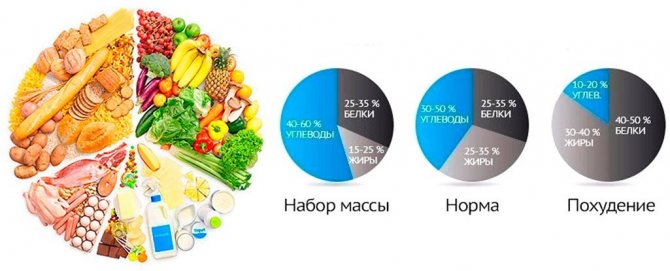
The ratio of proteins, fats and carbohydrates in the diet
You will be surprised how few products you need to consume to meet your daily requirement.
An example of the ratio of 100 g of product and the fats contained in it: walnuts - 60.8 g of fat, in dark chocolate 35.4 g, in ice cream 15 g, in Dutch cheese 26.6 g, in glazed cheese 27.7 g, in a chicken egg 11.5 g etc.
Research shows that high-fat diets, such as low-carb and Mediterranean diets, are actually much healthier than a standard low-fat diet.
One of the brightest and most obvious examples is the keto diet. It contains a large amount of fat and protein in the diet and a minimal amount of carbohydrates.
Is it possible to determine the amount of fat in the body yourself?
At home, they suggest using a special ruler - a caliper,
which resembles a caliper.
To do this, you need to measure the thickness of the folds at four different points (on the stomach, hips, chest, upper back). The results obtained are summarized. Then the resulting figure is compared with age, gender and standards in a special table. There are different standards for women and men.
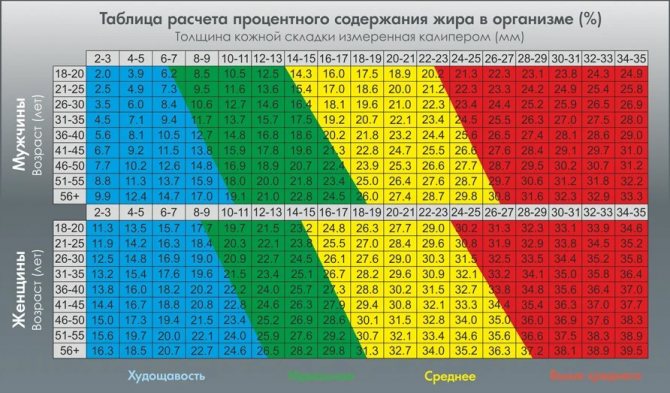
Correlation between sex, age and fold thickness measured by caliper
Fat Burning Products

Fats should be present in our diet, but if there is a need to get rid of extra pounds, many people go on low-calorie diets. At the same time, it is absolutely not necessary to torture yourself with diets and physical activity. It is enough to reduce your caloric intake and eat foods rich in healthy fats.
There are a number of products that, according to nutritionists, burn fat and accelerate lipid metabolism due to the fat-burning substances they contain:
- eggs
- contain a large amount of protein and healthy amino acids; - fruits
, especially citrus fruits, grapefruit, apples, pineapple, papaya - consist of healthy sugars, vitamins, minerals, peptins, and tocopherols. Rich in fiber, which speeds up metabolism and increases intestinal motility; - berries
- raspberries accelerate fat burning due to their high content of plant fibers. Nutritionists recommend eating a small amount of this berry 20-30 minutes before your main meal. Lipolytic enzymes are found in blueberries, blueberries, cranberries; - vegetables
- green vegetables (celery, sorrel, cabbage, zucchini, broccoli, cucumbers) most accelerate lipid metabolism. Rich in plant fibers, vitamins, and organically active compounds. They practically do not contain carbohydrates. Improve water-salt balance, accelerate lipolysis; - herbs, spices, seasonings
- to burn calories and speed up the breakdown of fats, season your favorite dish with spicy, hot spices (red, cayenne pepper, turmeric, ginger, mustard, horseradish). Spices activate metabolism 15-20 minutes after eating due to the content of essential oils; - products rich in plant and animal proteins
- chicken, dairy products, legumes. Protein is a building material for muscles, burns fat, stimulates metabolic processes at the cellular level; - water, green tea
- to speed up fat burning, a healthy person needs to consume at least one and a half liters of liquid per day. Unsweetened black tea with lemon, strong brewed coffee, green tea, herbal infusions, and regular bottled water do a great job of burning fat; - grains, cereals
- cereals not only enrich the body with useful substances and fill with energy, but also perfectly stimulate lipid metabolism.
Important!
The rate of fat burning is determined by the quantity and quality of proteins supplied with food. According to numerous studies, it has been found that increasing the amount of protein in the diet accelerates fat metabolism and overall metabolism.
If you decide to lose weight and achieve ideal physical shape, it is not enough to adhere to a balanced diet, healthy eating rules, and include products from the list above in your daily menu. The calorie content of food largely depends on the method of its preparation. For example, fried foods contain more calories than boiled or grilled foods.
Physical activity, control of fatty acids in the food consumed, adherence to the regime and daily routine will also help speed up the fat burning process.
What is the threat of a shortage?
A deficiency of fat in the body leads to a number of negative consequences: the condition of the skin worsens, the level of bad cholesterol increases, and the risk of developing cardiovascular diseases increases. The person experiences delayed physical growth and mental development. The reproductive system suffers significantly, which provokes menstrual irregularities in women, impairs potency in men or causes infertility.
However, an excess of fat is also dangerous, since it leads to the development of obesity, which impairs the functioning of all organs and systems. In addition, excess lipids are dangerous for the liver and pancreas and contribute to the development of cancer.
Fats serve many functions in maintaining the normal functioning of the body. However, it is worth remembering which lipids are beneficial and how much will be beneficial and not dangerous to health.
Low-calorie fat substitutes
The widespread prevalence of overweight and obesity among the population of economically developed countries has necessitated the search and development of low-calorie fat substitutes, and also attracted attention to low-fat “light” products.
There are two groups of fat substitutes.
First group
includes carbohydrates and proteins, the molecules of which are modified in such a way that they are able to bind large amounts of water, three times the mass of these substances.
The swollen particles give a feeling of fat when chewed, and the calorie content of these substitutes is reduced to 1-2 kcal/g. Among carbohydrates, low molecular weight starches, dextrins, maltodextrins and gums are used for such purposes. Protein fat substitutes are obtained from milk and eggs. Substitutes in this group are absorbed and metabolized like regular proteins and carbohydrates.
Second group
substitutes are synthetic substances that have the physical and technological properties of fats in food products.
Synthetic fat substitutes have different chemical natures, degrees of digestion and absorption, as well as different effects on the gastrointestinal tract.
They replace fat in food in an equivalent ratio by weight. Of the synthetic fat substitutes, the best known are esters of fatty acids with sugars, for example sucrose polyester. It should be emphasized that their safety and effectiveness are being studied.





